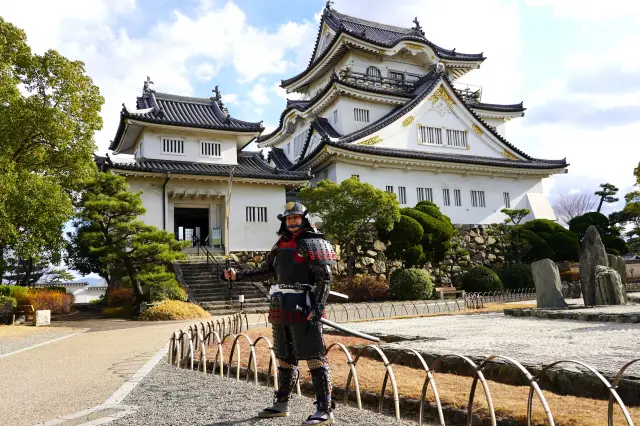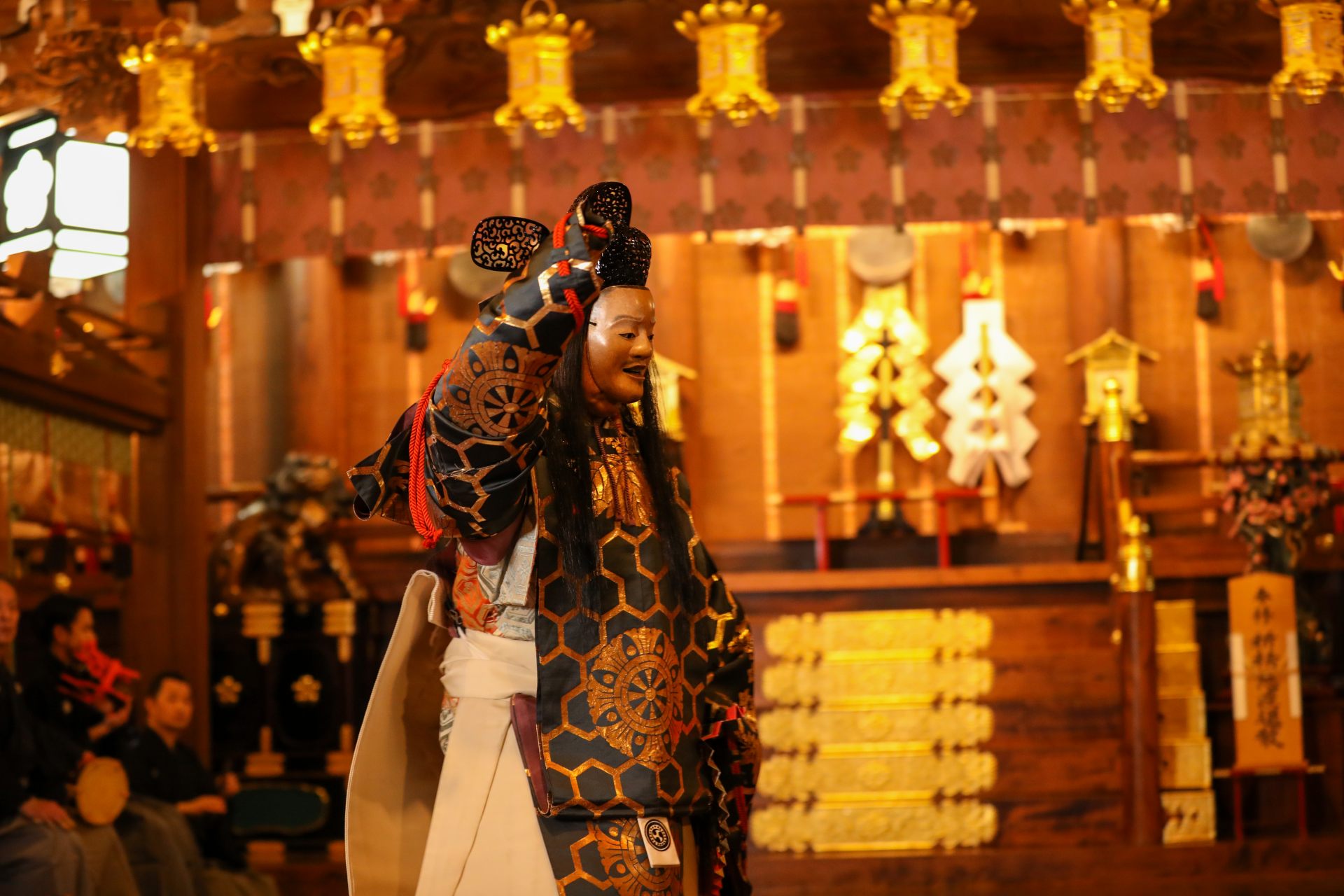
Exclusive Noh performance of "Takasago" by Tomoyoshi Ueno at Osaka Temmangu Shrine
Last update
Noh has a storied history with roots dating back to Japan’s Heian period (794-1185), and it was formalized as we know it today by the Muromachi period (1336-1573). Called nogaku in Japanese, it is widely recognized as the epitome of traditional performing arts in Japan and is registered worldwide as a UNESCO Intangible Cultural Heritage.
In this special cultural experience, guests are treated to witness a Noh play in an intimate setting with a lead performance by Tomoyoshi Ueno, a performer in the Kanze style of Noh, who is recognized as an Important Intangible Cultural Property in his own right. Through the performance of the play "Takasago", viewers have the rare opportunity to deepen their understanding of Noh and Japanese culture while taking in a relaxing and meditative theater experience filled with passion and spirituality.
The stage itself is also a key attraction as the performance is held within the Main Shrine of Osaka Temmangu Shrine, a historic shrine important to the people of Osaka. The stage is actually within the sanctum, normally off-limits to anyone other than the priests. Take a moment to immerse yourself in the world of Noh as it unfolds before your eyes in this spiritually charged atmosphere. There can be no doubt that the combination of the renowned performers and the storied location will be remembered as a once-in-lifetime experience.
"Temma no Tenjin-san" – a shrine close to the people of Osaka’s hearts
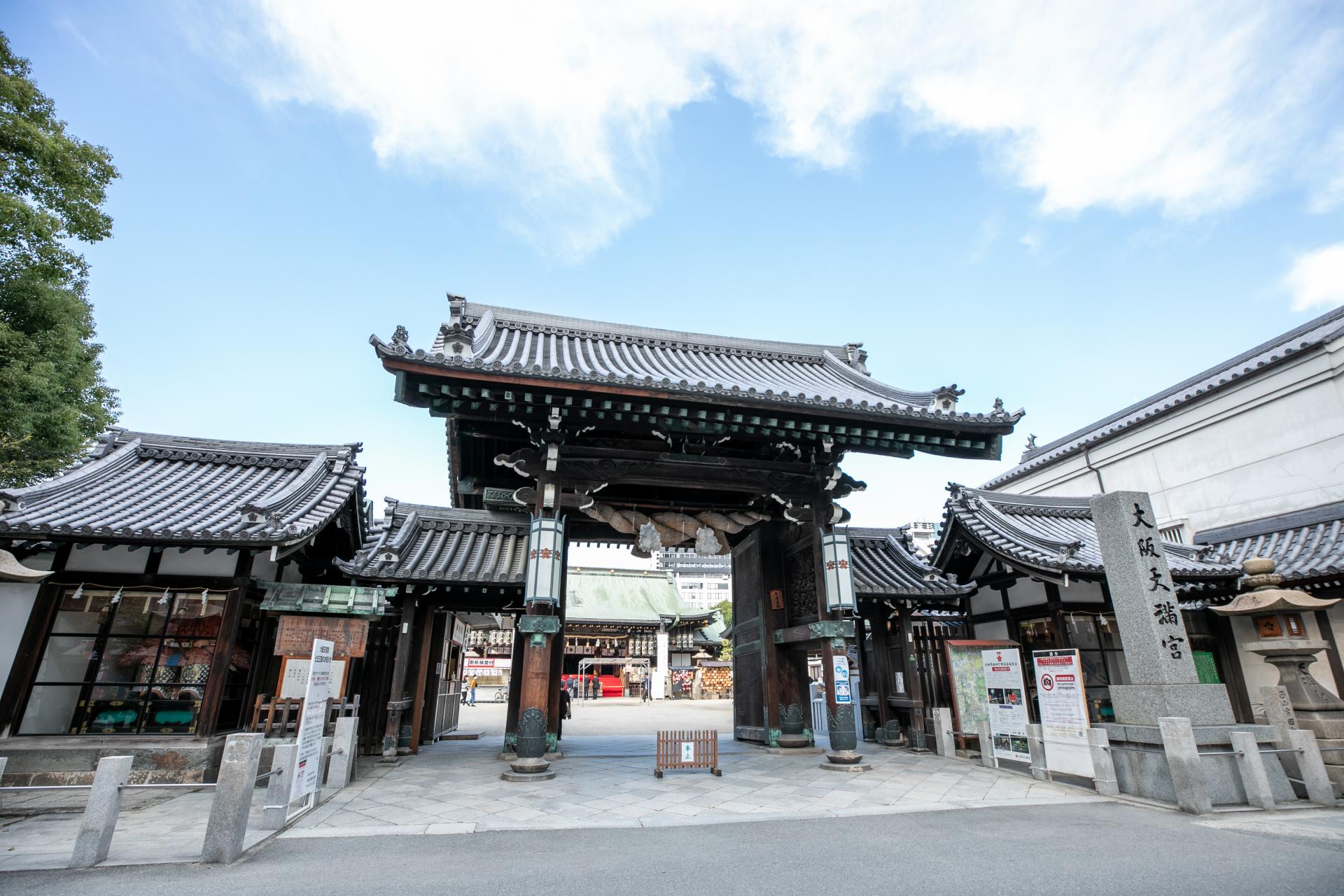
Nestled in downtown Osaka, the shrine attracts many worshippers and holds a special place in the hearts of Osaka locals.
Osaka Temmangu Shrine, with a history of 1300 years, is the stage for this special cultural experience. As the center of the Tenjin Matsuri, one of the three major festivals in Japan, the shrine is a sacred place that calls to people praying for successful endeavors, such as starting a new path in life or testing themselves through academic endeavors.
According to the shrine's historical records, when Emperor Kotoku built the Naniwa Nagara-Toyosaki Palace in this area as the capital of northwest Japan in the Nara period (710-794), he enshrined a guardian deity here and made this a Daishogunsha, a shrine that guards over the city. After that, the scholar and poet Sugawara no Michizane, who served as a minister in the Imperial Court during the Heian period (794-1185), visited the Daishogunsha and prayed for the safety of an important trip to the administrative capital of Dazaifu in present-day Kyushu where he would go on to face great hardship. Later, after the death of Michizane in Dazaifu, it is said that seven pine trees grew overnight in front of the Daishogunsha and the treetops emitted golden light. The story reached Emperor Murakami, who deified the spirit of Michizane and created the Daishogunsha on the same grounds as Osaka Temmangu Shrine.
Michizane was known as a scholar and for his skill in the performing arts, winning the respect of the local people and merchants of Osaka. To this day they colloquially refer to the shrine as "Temma no Tenjin-san" which means the deity of Temma, an abbreviation of Temmangu and the name of the local neighborhood.
A stage reserved for the gods
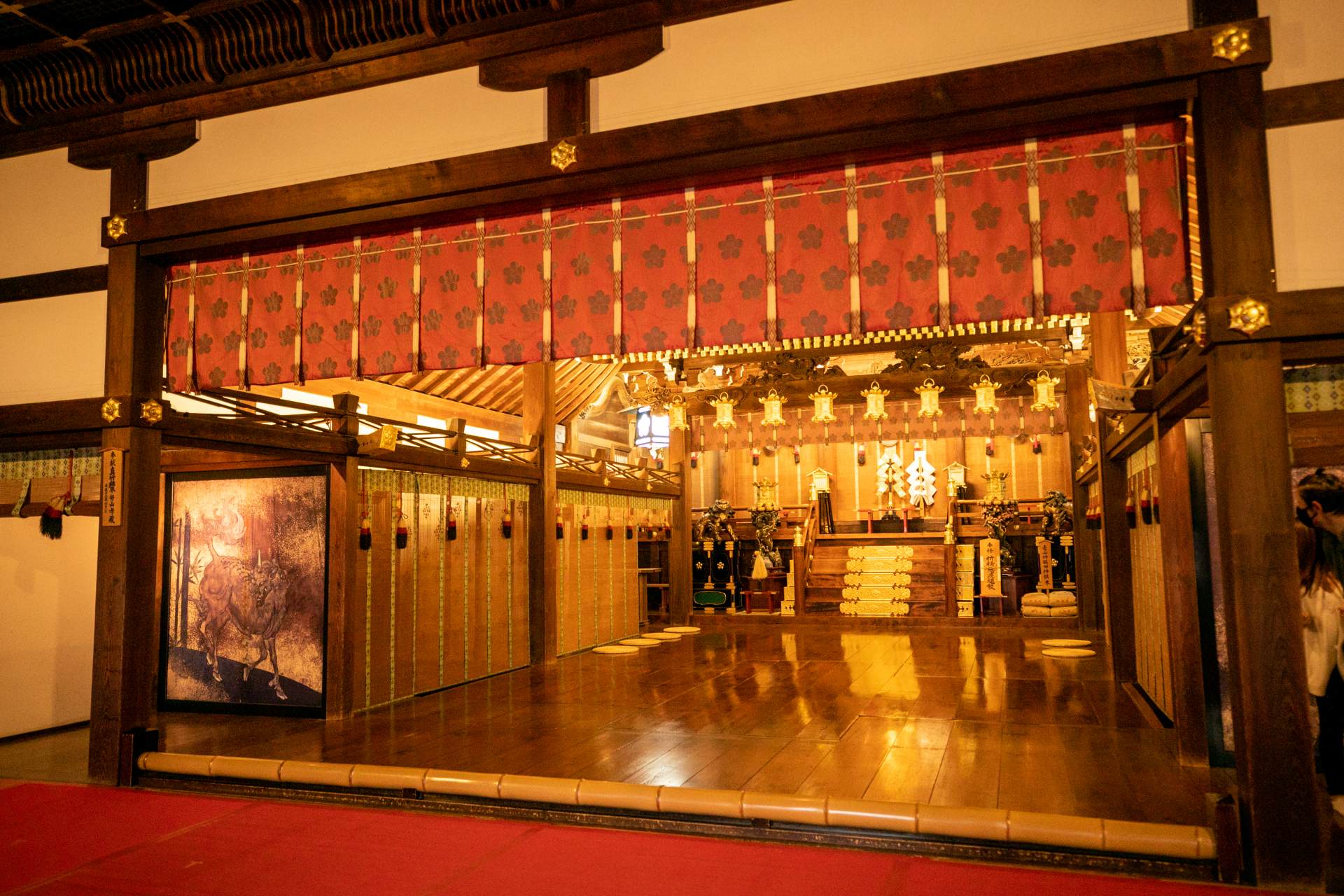
Inside the main hall with its majestic and sacred atmosphere. From the low bamboo partition to the altar in the back is the Haiden (hall of offerings).
At Osaka Temmangu Shrine, continues to be worshipped by the people of Osaka and is treated with great respect. When visitors first enter the shrine grounds from the large main gate, they are greeted with a magnificent shrine standing right in front. This is where Sugawara no Michizane, the main deity, is enshrined and the Noh special cultural experience is also carried out in this very location.
Over the centuries, Osaka Temmangu Shrine has been devastated by fires, and the shrine grounds were completely destroyed by the great fire caused by the Oshio Heihachiro revolt of 1837. The current main shrine building was rebuilt in 1843 at the end of the Edo period thanks to the devotion of the local community. Since then, it has a history of nearly 180 years, supported by the deep faith and bond of those who protect and rebuild "Tenjin-san" no-matter what hardships it faces.
The main shrine building is built in an architectural style called gongen-zukuri and from the front stands a number of grand halls connected by wooden walking paths covered with intricately detailed roofs. It is the largest wooden building in Osaka Prefecture and is a valuable building designated as a Japanese Registered Tangible Cultural Property.
From the outside, the architecture is impressive and majestic, but the true uniqueness of this experience is the chance to enter the shrine buildings and appreciate the details and intricacies up-close. When viewing the Noh performance there seems to be an almost divine air flowing through the tranquil space. The stage of the performance is in the most sacred area of the main building, which is only open to priests under normal circumstances. The connection between the shrine and Noh theater shows that the performance here is a sacred art. The priests and actors work together and understand that the performing art of Noh is in a sense an embodiment of the enshrined deities.
A masterclass in Noh
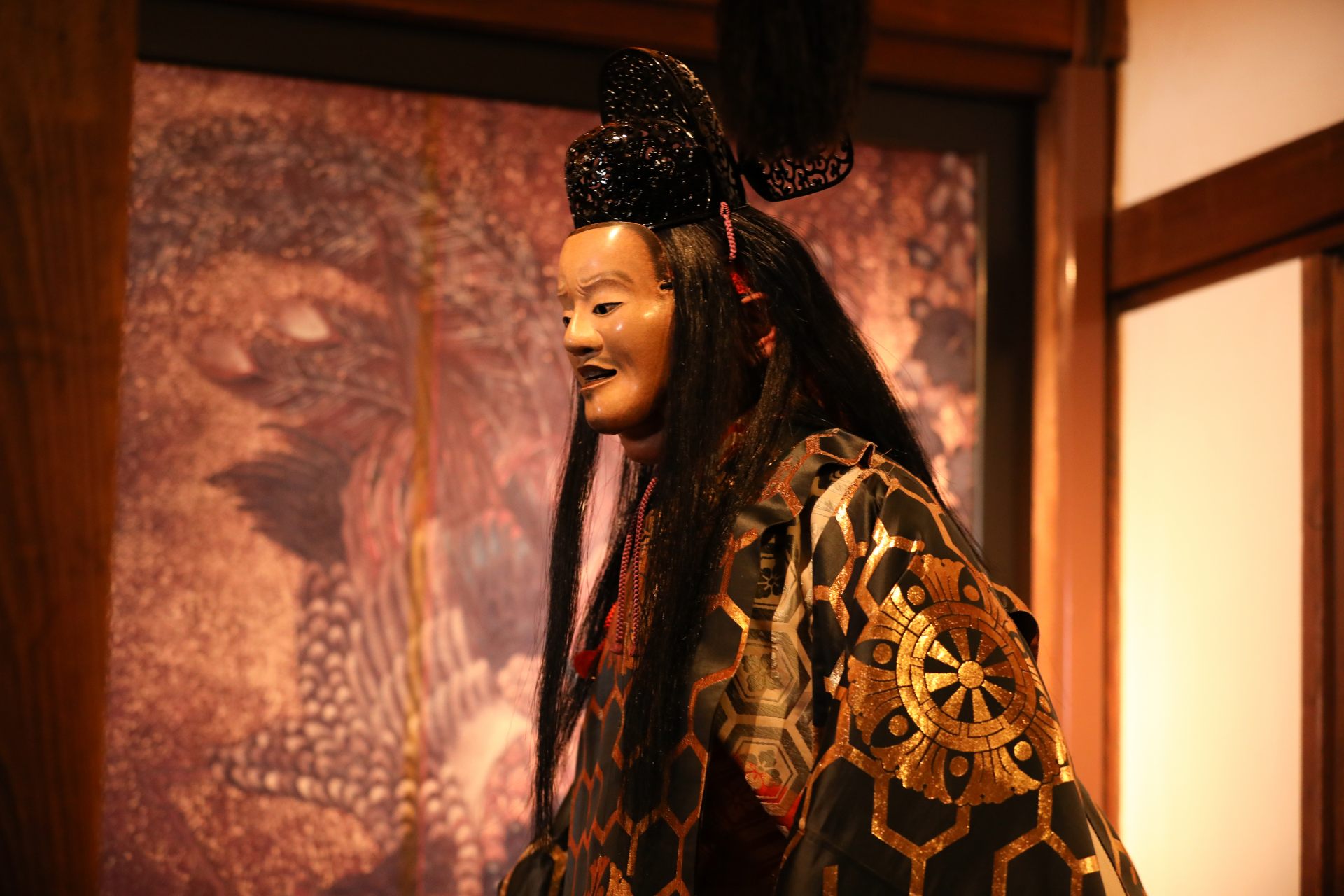
The appearance of the performer in mask and costume is a thing of transcendent beauty.
Only as part of this exclusive cultural experience will Noh be performed in the shrine area of the distinguished Main Shrine. Noh itself is a traditional performing art of Japan has been refined over and over again since its forms was formalized around 600 years by the father and son theater troupe of Kan'ami and Zeami in the Muromachi period (1338-1573). From bunraku puppetry and kabuki to contemporary drama and opera, Noh has influenced entertainment in Japan and around the world.
Noh is commonly called nogaku in Japanese, but to be precise, nogaku is a combination of Kyogen and Noh. Kyogen is a dialogue-focused drama, frequently based on everyday events and containing many elements of satire and comedy.
On the other hand, Noh is a form of song and dance paired with instrumental music and chants. It is a dramatic performance that depicts human emotions such as anger, sorrow, and love, all while developing a strong narrative. The acting and directing have been refined to the finest detail so that each and every movement and action of the performer has profound meaning, such as the weight of an individual footstep or the gentle upturn of the face. This attention to the most minute detail is said to be a characteristic of Noh that others forms of entertainment do not have to the same extent. Another unique point is that historical figures, spirits, gods, demons, and other non-worldly beings often appear as the lead protagonists called shite.
What further characterizes Noh is the mask called omote and the distinctive costumes called shozoku in Japanese. These are not just costumes or stage tools but play an important role in visually portraying the facial expressions and emotions of the performers and the nuances of the story. It is even said that the souls of gods and ancestors dwell within the omote, and they are valuable items passed down as heirlooms for generations within the Noh performer's family. The omote used in this performance are hundreds of years old.
Deepen your understanding of Noh and Japanese culture by watching the prestigious performance "Takasago"
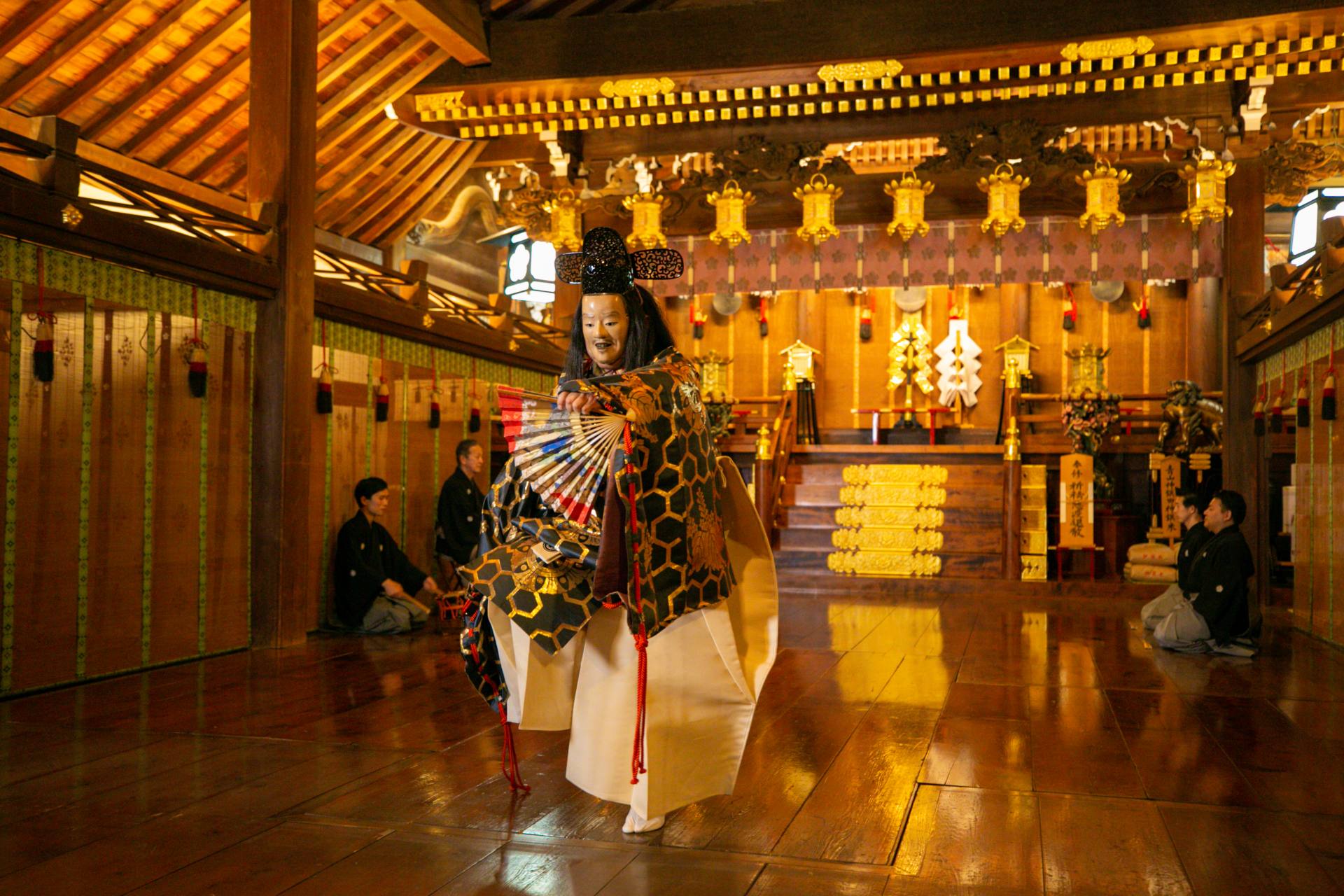
Important Intangible Cultural Property Tomoyoshi Ueno performs "Takasago" in the Kanze style.
Since the great success of Noh by Kan'ami and Zeami, countless performances have been created for the stage and more than 200 plays are still being performed today. Many of these performances accurately follow historical scripts stored in temples and shrines from stories that were widely known during the Muromachi period.
This is also true for the performance of “Takasago” by Tomoyoshi Ueno, an Important Intangible Cultural Property holder who performs in the Kanze style. This Noh play is deeply related to the Kansai region where Osaka is located, taking place as it does at Takasago Shrine in Takasago City, Hyogo Prefecture, and Sumiyoshi Taisha Shrine in Osaka City.
The story follows a priest who ventures behind Takasago Shrine where he meets an old couple sweeping up the needles of the pine trees that grow there. The priest is intrigued and asks about the history of the pine trees. Over the course of the narrative the couple reveals that they are actually the spirits of pine trees, the woman of the trees that grow at Takasago Shrine, and the man the trees at Sumiyoshi Taisha Shrine. The priest is then invited to visit Sumiyoshi by the couple before they both depart on a boat. When the priest arrives at Sumiyoshi, the masculine deity Sumiyoshi appears in front of him while dancing, and blesses the world with peace.
The theme of this performance revolves around the pine trees as a metaphor for enduring love and the poetry we impart upon the natural world. “Takasago” has been regarded as the most memorable and profound performance in which a deity shows us the way to a more peaceful world and the performance discusses the importance of spirituality and cultivating aesthetic sensibilities embodied by shrines. From ancient times, it has been considered a masterpiece in both structure and substance and has been performed as part of wedding receptions and celebrations of longevity.
Noh places a very high value on each word and action. By watching a performance in such an intimate setting, you will quickly become an expert on the subtleties of Noh. Enjoying Noh leads not only to an understanding of Noh, but also to a broader understanding of Japanese culture, and beyond that, to the meaning of life itself.
Preview the experience online
Check also...

Fastest & Cheapest Ways to Travel! A Guide to Getting from Tokyo to Osaka

Consider your accommodation in the Kansai area!

Restrictions on Large Baggage

Hidden Stories in Stone: Exploring Japan’s Castle Walls

Feel Like a Lord: Castle with Stunning Panorama Views

Experience the True Essence of Japan through Castles, Cultural Treasures, and Timeless Gardens
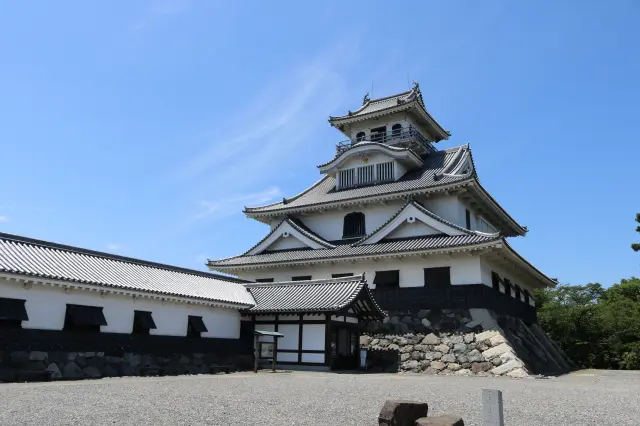
Castles of Toyotomi Hideyoshi
